The Matterhorn guided climb offers an unforgettable alpine adventure‚ combining breathtaking views with challenging terrain. With expert guides‚ climbers can safely navigate this iconic mountain’s steep ridges and exposed routes‚ ensuring a memorable experience for experienced mountaineers and ambitious climbers alike.
Overview of the Matterhorn and Its Significance
The Matterhorn‚ standing at 4‚478 meters‚ is one of the most iconic and recognizable mountains in the world‚ located near Zermatt‚ Switzerland. Known for its distinctive pyramid shape‚ it is a symbol of Alpine mountaineering and attracts climbers from around the globe. First ascended in 1865‚ the Matterhorn has become a benchmark for alpinists‚ offering breathtaking views and a challenging yet rewarding climb. Its strategic location on the border of Switzerland and Italy adds to its allure‚ making it a cultural and natural landmark. The Matterhorn is not just a mountain but an emblem of adventure‚ history‚ and the beauty of the Alps.
Why Choose a Guided Climb for the Matterhorn?
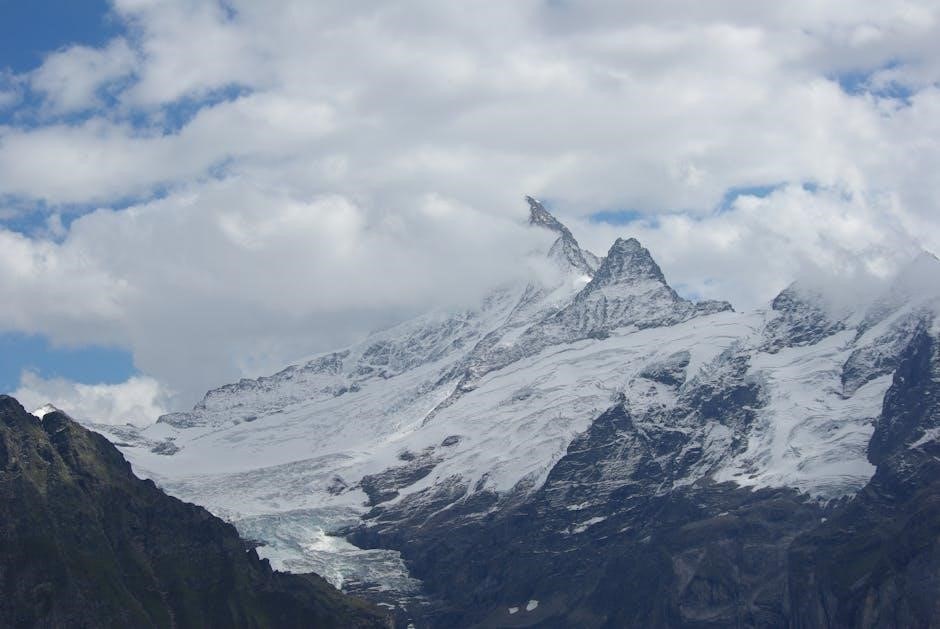
Choosing a guided climb for the Matterhorn ensures a safer and more successful ascent. Expert guides provide essential knowledge of the mountain‚ its routes‚ and potential hazards‚ helping climbers navigate technical sections and unpredictable weather. They assess each climber’s readiness and offer personalized guidance‚ enhancing both safety and performance. With a guide‚ climbers can focus on the experience while professionals handle logistics‚ route-finding‚ and crisis management. Additionally‚ guided climbs often include preparatory courses‚ ensuring participants are well-equipped for the challenge. This support system is crucial for tackling the Matterhorn’s demanding terrain‚ making the climb accessible to those with the necessary experience and ambition.
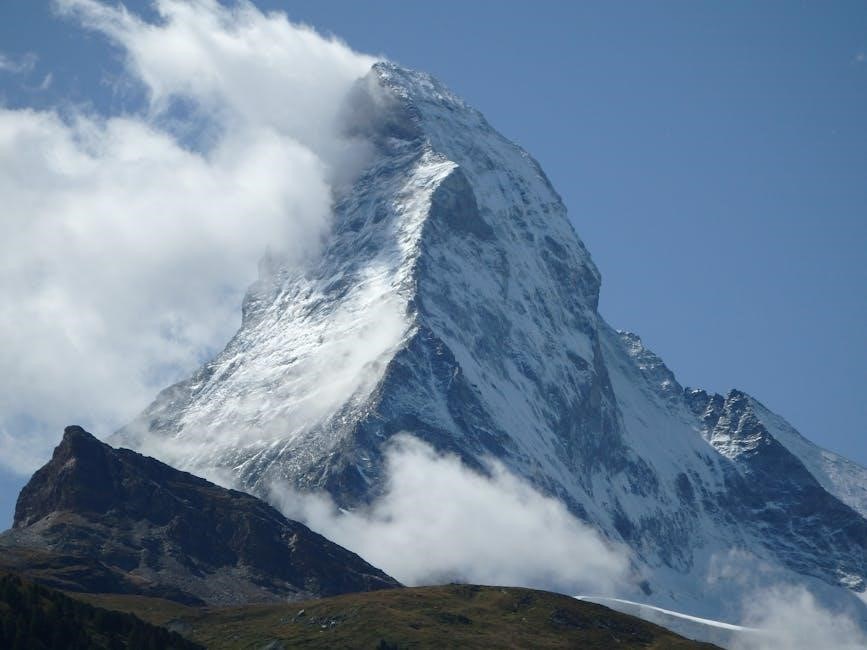
Climbing the Matterhorn: Costs and Inclusions
The Matterhorn guided climb starts from €3‚500‚ varying based on climb duration and group size. Prices include expert UIAGM-certified guides‚ ensuring a safe and personalized ascent experience.
Total Cost for a Guided Matterhorn Climb
The total cost for a guided Matterhorn climb typically starts from €3‚500 per person‚ varying based on the duration of the climb and the size of the group. This price generally includes the expertise of a certified UIAGM/IFMGA mountain guide‚ ensuring a safe and well-organized ascent. However‚ additional expenses such as lift passes‚ accommodation at the Hörnlihütte‚ and equipment rentals may apply. For instance‚ lift costs can range between €120 to €150 per person‚ and renting essential gear like crampons‚ harnesses‚ and helmets may add approximately €60. The 1:1 guide-to-client ratio is standard for safety and success‚ making the investment worthwhile for such an iconic climb.
What’s Included in the Price?
The price of a guided Matterhorn climb includes expert guidance from certified UIAGM/IFMGA mountain guides‚ ensuring a safe and structured ascent. The cost typically covers the guide’s fees‚ which encompass their expertise and leadership throughout the climb. Additionally‚ the price may include access to group equipment essential for the ascent‚ such as ropes and carabiners. Some packages also offer half-board accommodation at the Hörnlihütte‚ providing climbers with convenient lodging and meals during their preparation and climb. However‚ personal expenses like lift passes‚ additional gear rentals‚ and meals outside the provided packages are usually not included‚ allowing climbers to manage these costs separately based on their preferences and needs.
Additional Expenses to Consider
Beyond the base price‚ climbers should budget for lift passes‚ estimated at 120-150 CHF per person‚ and equipment rentals‚ such as crampons and ice axes‚ costing around 60 Euros. Accommodation at the Hörnlihütte‚ including half-board‚ averages approximately CHF 150 per night. Personal gear‚ meals outside the provided packages‚ and transportation to Zermatt are also extra. Climbers may need to cover guide expenses for lifts and accommodation. These additional costs can add up‚ so it’s important to plan accordingly. Always check with your guide service for specific inclusions and exclusions to avoid unexpected expenses during your Matterhorn adventure.
Role of Guides in a Matterhorn Climb
Guides provide expertise‚ support‚ and critical decision-making‚ ensuring climbers navigate safely and efficiently. Their deep knowledge of the mountain and experience are crucial for a successful ascent.
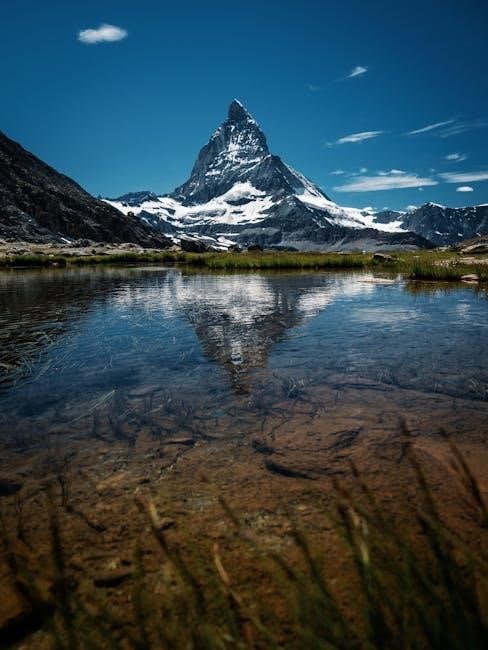
Qualifications and Experience of Mountain Guides
Matterhorn guides are UIAGM/IFMGA certified‚ ensuring high standards of expertise and safety. With over 15 years of experience‚ they possess deep knowledge of the mountain’s routes and conditions. Their extensive background allows them to assess climbers’ readiness and provide tailored support. Guides operate with a 1:1 client-to-guide ratio‚ ensuring personalized attention and maximizing safety. Their experience includes leading climbers through challenging terrains and varying weather conditions‚ making them indispensable for a successful ascent. Their qualifications and hands-on experience are vital for navigating the Matterhorn’s steep ridges and exposed routes safely and efficiently.
Client-to-Guide Ratio for Safety and Success
A 1:1 client-to-guide ratio is standard for Matterhorn climbs‚ ensuring personalized attention and enhanced safety. This setup allows guides to closely monitor each climber’s progress‚ providing immediate assistance when needed. With a focus on individual needs‚ the guide can adapt strategies to optimize success rates. This ratio also minimizes risks by enabling better communication and decision-making on the mountain. The close partnership fosters trust and confidence‚ crucial for tackling the challenging terrain. By maintaining a low ratio‚ guides ensure that each climber receives the support necessary to overcome obstacles and reach the summit safely.
How Guides Assess Climber Readiness
Guides assess climber readiness through evaluating experience‚ physical conditioning‚ and technical skills. They review prior climbing history and fitness levels to ensure climbers meet the demands of the Matterhorn. If a climber lacks necessary skills‚ guides may recommend preparatory courses or easier routes. This ensures safety and increases chances of a successful ascent. The assessment process is thorough‚ focusing on ability to handle steep terrain‚ exposure‚ and high-altitude conditions. Guides also check proficiency with essential gear like crampons and ice axes. This personalized evaluation helps tailor the climb to individual capabilities‚ maximizing safety and success rates on the mountain.
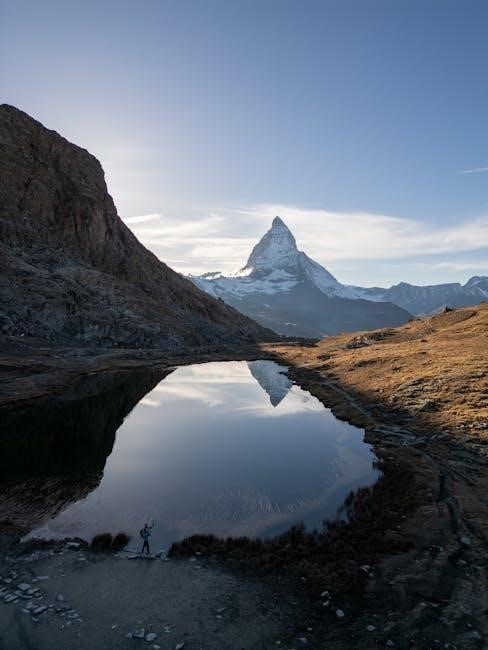
Difficulty Level and Required Experience
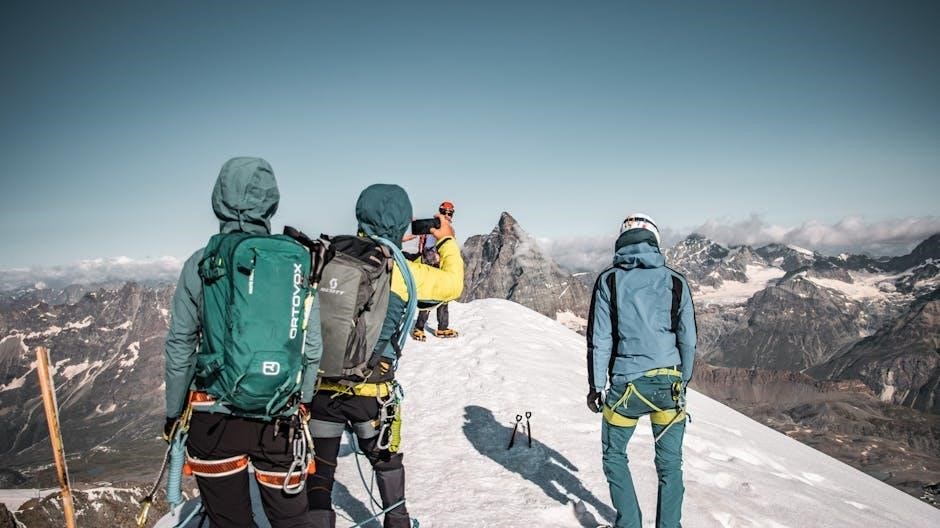
Climbing the Matterhorn demands high technical skills‚ excellent physical fitness‚ and prior alpine experience. Proficiency with ice axes and crampons is essential‚ along with comfort on exposed terrain.
Technical Skills Needed for the Ascent
Climbing the Matterhorn requires advanced technical skills‚ including proficiency with ice axes‚ crampons‚ and rope work. Climbers must be comfortable on steep‚ exposed terrain and able to navigate challenging rock and ice sections. Experience with glacier travel and crevasse rescue techniques is essential‚ as well as the ability to use climbing equipment such as harnesses and helmets. The climb involves high-altitude conditions‚ requiring strong physical stamina and mental focus. Prior experience with alpine routes is highly recommended‚ and many guides suggest completing a preparation course to ensure climbers are adequately prepared for the technical demands of the ascent. This ensures a safer and more successful climb.
Physical Conditioning Requirements
Climbing the Matterhorn demands excellent physical conditioning due to its high altitude and challenging terrain. Climbers must possess strong endurance‚ stamina‚ and overall fitness to handle the demanding ascent. The ability to carry a heavy pack and navigate uneven‚ steep paths is crucial; A high level of cardiovascular health is necessary to manage the physical strain at altitude. Flexibility and muscular strength are also essential for overcoming obstacles and maintaining balance. Proper training and acclimatization are vital to ensure climbers can safely and effectively tackle the mountain’s rigorous demands. Guides often assess climbers’ physical readiness to ensure they can meet the climb’s intense requirements‚ prioritizing safety and success. Physical conditioning is a cornerstone of a successful Matterhorn ascent.
Recommended Preparation and Training
To successfully tackle the Matterhorn‚ climbers should undertake specific preparation and training. A Matterhorn Prep Rock Course is highly recommended to build essential skills such as rope work‚ crevasse rescue‚ and glacier travel. Climbers should also engage in cardiovascular and strength training to improve endurance and stamina. Acclimatization is crucial; spending time at high altitudes before the climb helps reduce the risk of altitude sickness. Prior experience with alpine climbs of similar difficulty is beneficial‚ as it familiarizes climbers with exposed terrain and technical challenges. A 4-day or 6-day preparation program can refine climbing techniques and ensure readiness for the ascent. Proper preparation significantly enhances safety and success on the Matterhorn.
Matterhorn Guided Climb Itinerary
A typical Matterhorn guided climb spans 4 to 6 days‚ including a prep rock course‚ Hornli Ridge ascent preparation‚ and summit day. Guides ensure a structured‚ safe experience.
Typical Duration of the Climb
A Matterhorn guided climb typically lasts 4 to 6 days‚ including preparation and acclimatization. The ascent via the Hornli Ridge is usually a 2-day endeavor‚ with the summit reached on the second day. Climbers often spend a day in Zermatt for final preparations and a briefing with their guide. The climb itself involves an early morning start from the Hörnlihütte‚ ascending steep terrain‚ and navigating exposed ridges. The duration may vary depending on the climber’s pace and weather conditions‚ but the structured itinerary ensures a safe and efficient approach to the summit.
Detailed Daily Schedule
A typical Matterhorn guided climb follows a structured 4-day itinerary. Day 1 involves arrival in Zermatt‚ equipment checks‚ and a briefing with your guide. Day 2 focuses on acclimatization‚ with a warm-up climb or training session. On Day 3‚ climbers ascend to the Hörnlihütte‚ where they rest and prepare for the summit push. Day 4 begins early with a challenging ascent via the Hornli Ridge‚ aiming for the summit and returning to the hut. Day 5 is reserved for descent and departure. This schedule ensures climbers are well-prepared and acclimatized‚ maximizing their chances of a successful and safe ascent.
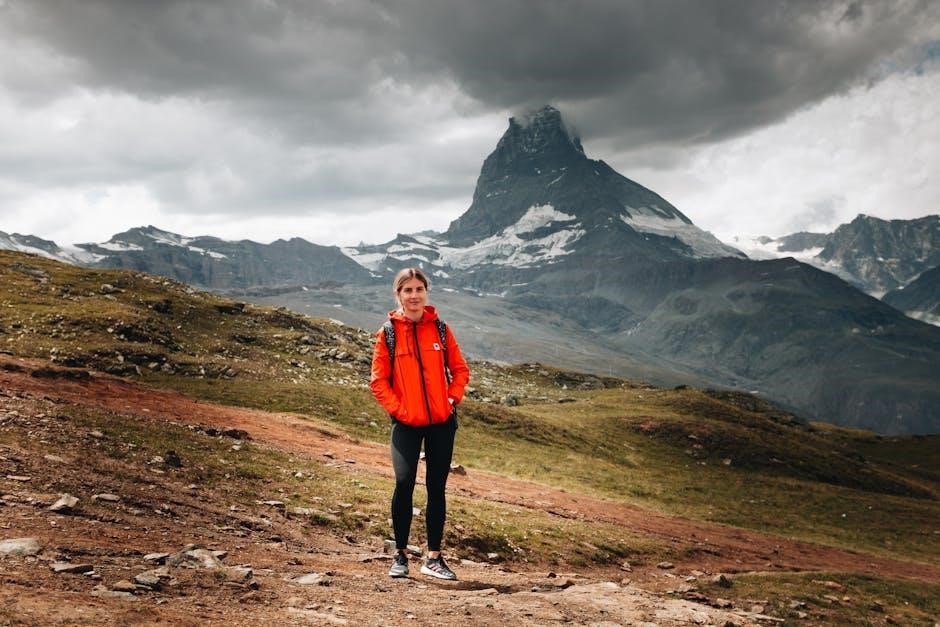
Accommodation Options
During a Matterhorn guided climb‚ climbers typically stay in Zermatt before and after the ascent. Mountain huts like the Hörnlihütte provide overnight stays at around CHF 150 per person‚ including half-board. These huts offer basic but comfortable lodging‚ allowing climbers to rest and prepare for the summit push. Additional costs for accommodation and meals are usually not included in the initial guiding fee and must be covered by participants. Guides often assist in booking these arrangements to ensure a smooth experience. Staying in these huts is essential for acclimatization and proximity to the climb‚ making them a practical choice for climbers.
Equipment and Gear for the Climb
Essential gear includes ice axe‚ harness‚ crampons‚ and helmet. Rentals are available for €60 per person. Guides cover their own equipment expenses‚ ensuring climbers are well-prepared.
Essential Climbing Gear
Climbing the Matterhorn requires specific gear to ensure safety and success. Essential items include a sturdy ice axe‚ a reliable harness‚ crampons for icy terrain‚ and a durable helmet. These items are crucial for navigating steep‚ exposed sections and icy slopes. Additionally‚ climbers should have warm‚ layered clothing‚ gloves‚ and sturdy mountaineering boots with good grip. A backpack for carrying gear and a headlamp for early starts are also necessary. While some items can be rented‚ such as crampons and ice axes‚ it’s important to ensure all gear is in excellent condition. Proper equipment is vital for tackling the Matterhorn’s challenging terrain safely and effectively.
Rental Options for Equipment
Rental options for Matterhorn climbing gear are readily available in Zermatt and nearby towns. Climbers can rent essential items like crampons‚ ice axes‚ harnesses‚ and helmets at local outdoor shops; Costs typically range from 60 Euros per person for a full set of gear. Many guides recommend renting equipment to ensure proper fit and quality. However‚ personal items like mountaineering boots should ideally be purchased to guarantee comfort and performance during the climb. Rental shops often offer packages tailored to Matterhorn climbers‚ providing everything needed for the ascent. This convenient option allows climbers to avoid transporting heavy gear while ensuring they have the right equipment for the challenge.
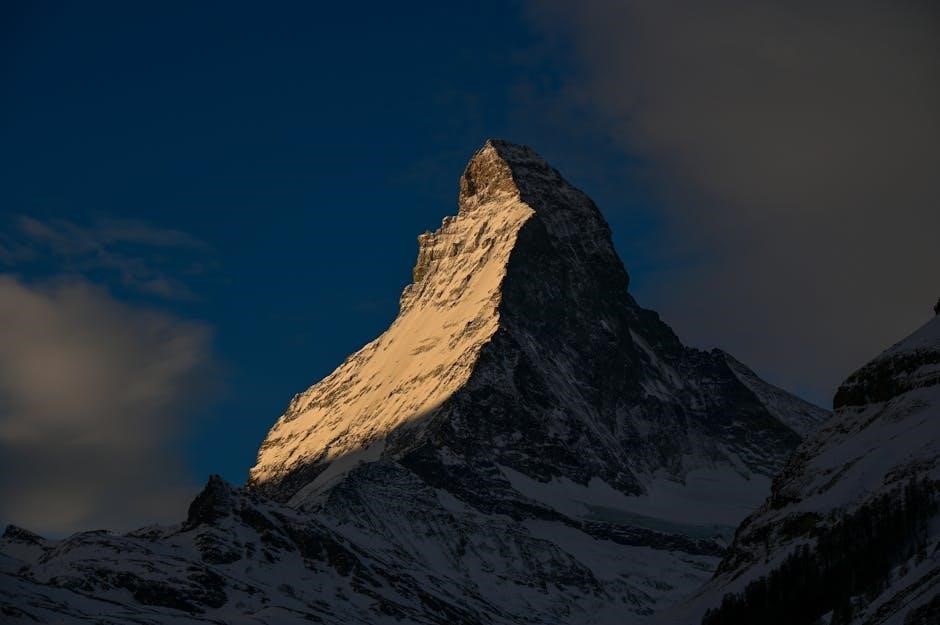
Safety and Risks
The Matterhorn climb involves inherent risks like steep ridges‚ rockfall‚ and unpredictable weather. Safety measures include emergency protocols‚ experienced guides‚ and careful route planning to mitigate hazards.
Common Hazards on the Matterhorn
Climbers face several hazards on the Matterhorn‚ including steep and exposed terrain‚ unpredictable weather conditions‚ and rockfall. These risks are mitigated through expert guidance‚ careful route planning‚ and adherence to safety protocols. Weather-related challenges such as snowstorms or icy conditions can increase the difficulty of the ascent‚ while the high altitude poses its own set of physical demands. Additionally‚ the risk of avalanches and crevasses‚ particularly in certain sections‚ requires constant vigilance. Guides play a crucial role in assessing these hazards and ensuring climbers navigate them safely‚ making their experience both challenging and secure.
Weather Conditions and Their Impact
Weather conditions play a critical role in the Matterhorn guided climb‚ with unpredictable snowstorms‚ high winds‚ and rapid temperature changes posing significant challenges. These conditions can increase the difficulty of the ascent‚ reduce visibility‚ and make the terrain more hazardous. Climbers must be prepared for variable weather‚ as it can impact both safety and route accessibility. Guides closely monitor weather forecasts to ensure optimal climbing windows and may postpone the ascent if conditions become too hazardous. The ever-changing weather adds an extra layer of complexity to the climb‚ requiring adaptability and experience to navigate safely and successfully. Proper preparation and guidance are essential to mitigate these risks.
Safety Measures and Emergency Protocols
Safety measures and emergency protocols are paramount on a Matterhorn guided climb. Guides implement rigorous risk assessments‚ ensuring climbers are properly equipped and trained. Emergency response plans include immediate evacuation procedures‚ with heli-rescue options available in critical situations. Communication devices are carried at all times‚ enabling rapid coordination with rescue teams. Climbers must adhere to guide instructions to minimize risks. Regular checks on equipment and terrain stability are conducted to prevent accidents. These protocols ensure a secure environment‚ allowing climbers to focus on their ascent while knowing help is readily available if needed. The emphasis on preparedness and quick response underscores the commitment to safety on this challenging climb.
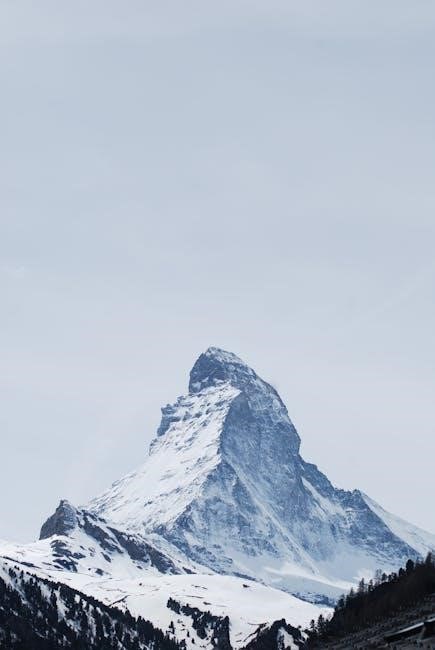
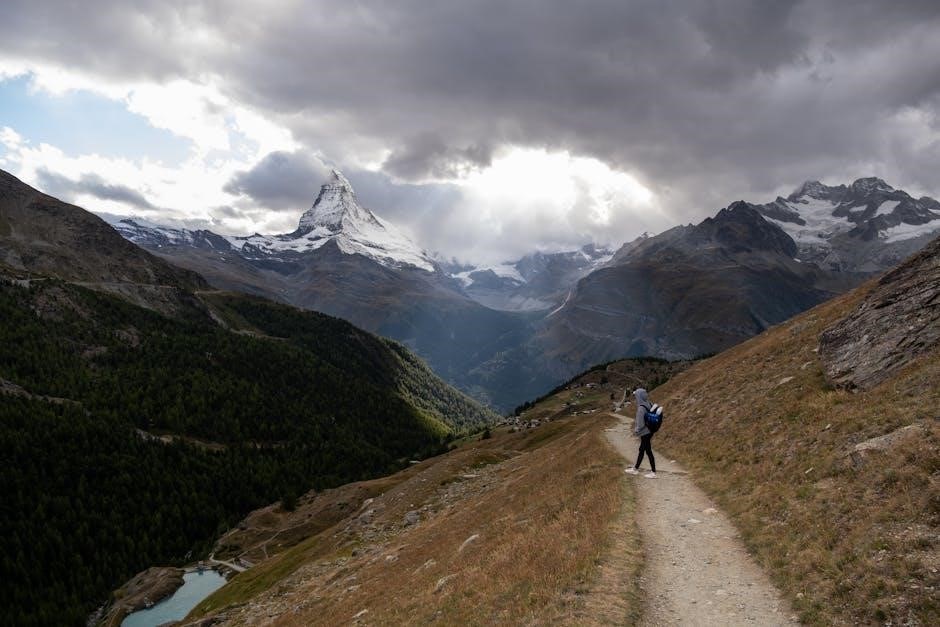
Climbing Experience and Highlights
The Matterhorn guided climb offers an unparalleled alpine experience‚ blending challenging terrain with breathtaking vistas. Climbers traverse the iconic Hornli Ridge‚ experiencing steep rock faces and exposed ridges‚ culminating in a triumphant summit with panoramic views of the Swiss Alps. The journey is a mix of physical challenge and natural beauty‚ creating lifelong memories for those who dare to conquer this legendary peak.
The Hornli Ridge Route
The Hornli Ridge Route is the most popular and iconic path to the Matterhorn summit‚ known for its steep‚ exposed terrain and high-altitude climbing. This challenging route demands a strong physical condition and solid mountaineering skills. Climbers navigate narrow ridges‚ rocky sections‚ and glaciers‚ with breathtaking views of the Swiss Alps. The route typically takes 4 days‚ including acclimatization and preparation. Guided ascents ensure safety and success‚ as expert guides lead climbers through the technical sections. The Hornli Ridge is renowned for its dramatic exposure and stunning vistas‚ making it a must-do for experienced climbers seeking an unforgettable alpine adventure.
Summit Experience and Views
Reaching the Matterhorn summit is a breathtaking achievement‚ offering panoramic views of the Swiss and Italian Alps. Climbers experience a profound sense of accomplishment‚ standing atop one of the world’s most iconic peaks. The summit provides a 360-degree view of surrounding mountains and glaciers‚ creating a truly unforgettable moment. The Matterhorn’s unique pyramidal shape makes it a standout landmark‚ and its rugged beauty is unmatched. With expert guides‚ climbers can fully immerse in this experience‚ capturing memories of a lifetime. The descent from the summit is equally rewarding‚ with the same stunning vistas accompanying climbers back down‚ leaving a lasting impression of the Matterhorn’s grandeur.
The Matterhorn guided climb is a challenging yet rewarding endeavor‚ offering breathtaking views and unforgettable experiences. With expert guidance‚ climbers achieve personal growth and create lifelong memories safely.
Final Thoughts on the Matterhorn Guided Climb
Embarking on a guided Matterhorn climb is a transformative experience‚ blending personal challenge with stunning alpine beauty. The journey‚ while demanding‚ offers profound rewards‚ fostering growth and creating lasting memories. Expert guides ensure safety and success‚ making the ascent accessible to determined climbers. The Matterhorn’s iconic status attracts adventurers worldwide‚ promising an unforgettable adventure that combines technical skill‚ physical endurance‚ and mental fortitude. For those willing to embrace the challenge‚ the summit awaits‚ offering breathtaking panoramas and an overwhelming sense of achievement. This climb is not just a mountaineering feat but a journey of self-discovery and inspiration.
Why It’s Worth the Investment
Investing in a guided Matterhorn climb offers unparalleled value for aspiring mountaineers. The expertise of certified guides enhances safety and success rates‚ while the structured itinerary ensures a well-organized experience. The cost includes professional guidance‚ preparation courses‚ and essential support‚ making it a comprehensive package. Climbers gain not only the technical skills needed for the ascent but also lifelong memories and a sense of accomplishment. The unique blend of challenge and beauty makes the Matterhorn a worthwhile investment for those eager to push their limits and experience one of the world’s most iconic peaks.


